
Estimated reading time: 20 minutes
Sea Eagle brand inflatable kayaks are among the most popular recreational kayaks in America. I’ve owned a Sea Eagle model 370 sports kayak for ten years and decided it’s time I post a review.
The model 370 is essentially the same as the model 330. I have also owned a 330, and although this review is on the 370, most of what I write also applies to the 330.
Summary Up Front
| Good Tracking | Poor Handling – Not A Fast Boat |
| Good Stability | High Profile Seats – Different Balance For A Kayak |
| Easy Setup for an Inflatable | Cannot Attach “D” Ring Accessories (Due to Hull Construction) |
| Complete Kit includes Paddle(s), Air Pump, and Storage Bag | |
| Very Durable Construction | |
| Very Affordable for it’s Class | |
| Easy to Store and Transport |
Description
Sea Eagle is one of the largest inflatable boat manufacturers in America. In their current product line-up, they offer twelve different model inflatable kayaks in addition to various types of inflatable boats and stand-up paddleboards (SUP). Sea Eagle claims they have been manufacturing a version of the 330/370 inflatable kayak since 1968.
The model 370 is 12 feet 6 inches long, 34 inches wide with 10-inch diameter side tubes. The hull weighs 32 pounds and has a 650-pound carrying capacity. Sea Eagle claims the boat can carry up to three people, but effectively this boat is best for two people (tandem). It can be configured for just one person (solo).
The model 330 is 16 inches shorter with a hull weight of 26 pounds, and a carrying capacity of 500 pounds. This model works best with one person, although it can hold two people. Both models use the same seats, paddles, and air pump accessories.
There are several different package configurations available, but accessories in their standard package include:
- Seats – Two inflatable seats. Two different options available; the “SEC,” or the higher end “Deluxe.” The seats are held in place by friction fit with the sides of the hull.
- Kayak Paddles – two four-piece aluminum and plastic paddles.
- Foot pump with different tips, only one of which is needed for the standard “Boston” style air valves used on the kayak.
- Side tube inflation monitor.
- Storage bag.
- Skeg Guards – Two inflatable “donuts” to wrap around the skegs while in storage
- Repair kit.
- Owners manual and manufacturer “Certificate of Origin,” needed in localities that require registration for human-powered watercraft.
I’ve owned my 370 since 2013 and used it extensively over these past years. Although I only paddle flatwater, the 330/370 is rated for class III whitewater use. The simple color scheme of white hull with blue striping and lettering makes for a nice-looking boat.
Hull Construction
Inflatable kayaks come in three basic constructions; low pressure (1.1 PSI), high pressure (8-10 PSI) “” inflation, or a combination of these. The Sea Eagle 370 has two low-pressure side tubes, low pressure I-beam construction (tubes) for the floor, and inflatable fore and aft decking. The seats are also low-pressure inflatables. All pressure fabric is a tough 33 mil Polykrylar (K80 PVC).

This hull design is also considered “,” as the pressurized fabric is also the exterior of the boat. The Inflatable I-beam flooring is composed of five inflatable tubes which create “” to improve tracking. There are two skegs made of PVC which are permanently welded on. The fore and aft inflatable splash decks are held in place by blue and white cord rigging. These cords also form fore and aft carrying handles.
Between the two hull tubes, flooring, and fore and aft decks the one-piece hull has five separate air chambers. Include the two inflatable seats, and there are a total of seven air chambers on this boat. One important note is that the hull fabric stretches between its deflated to inflated size. Because of this, Sea Eagle recommends not gluing any accessory “D” rings or stickers (registration labels) onto the hull. This limitation requires a workaround for owners in states that mandate kayak registration.
The hull also includes a stern drain plug. Sea Eagle recommends keeping this plug open while paddling whitewater, otherwise it can be closed. The plug also helps draining out the boat while cleaning. Once deflated, the hull easily rolls up for storage.
Seat Configuration
One nice feature of this boat is that it can be used as either a tandem or solo boat. The seats are held in place by friction fit with the side tubes. So for tandem use, one seat is placed all the way aft as far as it can be pushed. Then the other seat is placed slightly forward of center point, and can be adjusted depending upon how much space the rear passenger’s legs need. For solo paddling, simply place one seat slightly aft of center point. This provides a large amount of fully accessible cargo space. Together with a 650 pound cargo capacity, the solo configuration makes the 370 an excellent boat for hauling a lot of camping or fishing gear.
Storage
The entire package all fits inside the provided storage bag, and the bag is small enough to fit into the trunk of even a compact car. No car roof rack is needed for transport. The bag has a nylon strap with hook for closure, and a single shoulder strap to carry it. The single shoulder strap makes for an uncomfortable and awkward carry, given the weight and size of the complete kit. There is also no attached pouch to hold small items (such as the repair kit and inflation monitor).
Storage Issues
The storage bag is large enough to hold everything, provided the hull does not unroll inside the bag. There is no strap provided to hold the rolled-up hull together. So, packing away the hull loose means it will unroll inside the storage bag, making it hard to pack the rest of the kit. I’ve added a nylon strap on mine to hold the hull together in storage. I don’t know why Sea Eagle doesn’t provide this strap – some other manufacturers do provide one for their boats.
Unlike most inflatable kayaks, the Sea Eagle 370 skegs are permanently molded onto the hull (on most other inflatables the skegs are removable). So, when the hull is rolled up, the skegs tend to fold over and pull down to the hull. After a while in storage, these skegs will be permanently folded over and no longer provide any “bite” in the water.
Sea Eagle does provide two inflatable “donuts” they ambitiously call “skeg guards,” which are supposed to keep the skegs from folding over. But I’ve found these are useless. There is a Do-It-Yourself solution available; maybe someday Sea Eagle will discover this.
Setup
Setup is very straightforward. First unpack everything from the storage bag. Unroll the hull and screw-in the five air valves – one each on the fore and aft decks, and three for the hull (one on each side tube and one for the floor) which are mounted at the stern. You’ll also want to set out the seats as you’ll need to inflate these. You’ll also need the inflation monitor Sea Eagle provides to set the side tube pressure accurately.
One really nice feature of this kayak is that all the air valves are the same type. So, you don’t need to change air pump tips as you inflate the various chambers. Despite the number of air chambers to inflate, with a bit of practice setup time can be under 30 minutes.
Having multiple air chambers for an inflatable boat is required for , a US Coast Guard requirement, and is an important safety feature. If one air chamber deflates while you’re out on the water, you can still paddle back to shore.
Side Tube Inflation
It’s important to inflate the side tubes to their correct pressure. These provide the overall rigidity, and if under-inflated the boat will sag where the passengers are sitting. This reduces performance, and the boat already isn’t a high-performance boat. It is possible to over-inflate but given the friction fit of the pump into the , you’re not going to be able over-inflate by much. However, leaving the boat sitting in the sun out of water may cause the air inside the tubs to expand. If you over-inflated them, the tubes could burst a seam from excess pressure.
I normally inflate the hull’s two side tubes first, but that’s just personal preference. The standard kit includes a bellows-style foot pump. I find this much easier to use than a hand pump but it still gives your legs a workout. The pump does move enough volume that the tubes inflate fairly quick. Connect the hose to the pump bellows and select the correct tip for the hose end. Sea Eagle provides several different air hose tips, even though the boat and seats only uses the one type of valve.
As you inflate, you’ll see the tube fabric will stretch. Use the inflation monitor to get to the correct air pressure. Simply match the lines on the monitor with the lines printed on the hull tube. Once these lines match, the tube is at the correct pressure. Be aware that the air pressure will increase if the kayak is left in the sun, and decrease if the water is excessively cold.
Floor
The inflation monitor is a simple way of getting the correct pressure in the side tubes, but it isn’t used for the floor. I don’t know why. So, when inflating the floor, you have to guess the correct pressure. Compare stiffness of the side tubes with the floor as you inflate it. The floor will be in direct contact with the water, so pressure will tend to decrease once the kayak is waterborne.
Decks
The last sections I inflate are the fore and aft splash decks. These two sections are held onto the hull with rope rigging. Their most important function is to give the kayak its overall bow and stern shape. Once again, the inflation monitor doesn’t work here, so just inflate until the decks are stiff. The boat’s Hull Identification Number (HIN) is stamped on the rear splash deck.
Seats
As personal preference, I always inflate the seats last. The deluxe seats are a bladder style, with two inflation bladders each, one for the base and one for the back, inside a thick canvas cover. These are not comfortable seats, but I’ve found that keeping pressure soft in the seat base helps some. I normally inflate the back to be rigid. The nice features of the deluxe seats over the SEC include a small storage pouch in the back, and the connecting straps that allow some adjustment for the seat back.
The friction-fit seat design has pros and con. On the pro side, you can place the seats wherever you want, not restricted by hooking to D-rings. This really helps increase comfort for the passengers. On the con side, the seats do tend to slip their position, especially the front seat. Adding a piece of “rug gripper” (no-slip rug pad) material under the seat can help reduce slippage.
Inflation Tip
Because this is a low pressure-style kayak, inexpensive electric air pumps are an option. A 12VDC air pump, the type used for air mattresses, can be used to inflate the kayak to close to full pressure. Then finish off with a few strokes of the foot pump while using the inflation monitor.
Using just the standard foot pump, my wife and I can setup and get into the water in about 25 minutes. With an electric air pump and the foot pump, working together, we’ve gotten setup time down to under 15 minutes.
Paddles
The paddles are a four-piece style, which is a great storage space saver over two-piece designs. The paddle blades are shaped for a right- and left-side. It’s important to get them assembled correctly for effective paddling.
Finish and Go
Once everything’s been inflated and paddles assembled, set the seats inside the hull at locations of your choosing, and you’re ready to go.
The rope rigging for fore and aft decks also creates carrying handles at bow and stern. With two people, these handles are a good way to lift the boat into the water if you’re launching from a pier. If launching from a beach/boat ramp, move the boat into the water stern first. This helps keep the skegs from being pushed flat.
Handling
The 370 is an easy boat to paddle around. It is not meant to be a “fast” boat, but it is reasonably comfortable. It does have a high profile compared to most kayaks, both inflatable and hard-shells, due to the floor design. The deluxe seats also have a relatively thick base, which together with the floor puts passengers higher up in the boat compared to most other kayaks.
With two people the boat handles well. With one person paddling solo, the boat is a little “light,” and prone to being blown around in even moderate winds. If one person was carrying a lot of gear, that extra weight would improve handling.
Stability
The boat feels a bit “tippy” when first getting in. This is due to the 15 inch wide floor being the only part of the hull with direct water contact, without any weight in the boat. The stability created by the floor is called “primary stability,” and this does initially feel a little unstable. However, as as you add weight (people) the side tube comes into water contact and provides “secondary stability.”
With a little practice, keeping the boat stable will become second nature. My wife and I have had this boat out in open water with chop and decent wind, but we’ve never been dunked.
Tracking
Tracking is an important feature of a kayak. This boat tracks quite well for an inflatable. I’ve learned to especially like the short dual skegs. Most inflatables have a flat bottom and use a single rigid skeg (nominal 8 inches long) that snaps onto the bottom. That means the kayak needs at least ten inches of water, and the rigid skeg can get the boat stuck in mud or rocks.
The 370’s short dual skegs, combined with the bottom chines, makes for excellent tracking, and I can get into water as shallow as five inches. Being soft rubber, the skegs will bend if they touch bottom. I’ve never gotten stuck in this boat paddling around in marshes or in water with rocky bottoms.
Cleanup
Deflate the hull and seats by unscrewing the air valves. The prevent the valves and dust caps from getting lost.
I make a point of cleaning and thoroughly drying my kayak after each use. As the hull is one piece, cleanup is rather easy. I’ll inflate the hull first. Then, I’ll sponge it down with special attention to water stains common from paddling in marshy areas. Let it dry, with final wipe down in the deep crevices at bow, stern, and where the side tubes and floor meet. I’ll also let the seats dry well. As they’re fabric covered, they usually need a day or so to dry properly.
Then roll the hull back up, and store all the parts back in the bag ready for the next trip.
Although the hull fabric is tough, it does stain. I happen to use a lot of sun blocker on my exposed skin during warm weather paddling. I’ve discovered that some sun blocker brands will create orange-colored hull stains where my knees and thighs come into contact with the side tubes. I’ve also discovered that if the hull is packed away damp (or with wet patches) mold can form and create black stains.
Abrasive cleaners on the hull are not a good idea, as excessive use may weaken the fabric. I use liquid car wash detergent for wiping down the hull, and Simple Green® cleaner for any tough stains. I also wipe on a protectorate after washing, as I’ve found that helps prevent staining. My current favorite is 3M brand 303 Aerospace Protectant®.
Durability
I’ve had no durability issues in the ten years I’ve owned and used this boat, paddling both fresh and saltwater. I’ve bounced this boat off a number of rocks, scraped submerged tree limbs, and dragged it over sandy beaches, with no damage. During the same time, I’ve put a number of scrapes and bruises on my rotomolded hard shell kayak.
The single problem I’ve had is with the plastic keepers on the air valve dust caps. After nine years use, the air valve keepers started breaking off. The air valves are easily replaced through Sea Eagle. Note that broken keepers does not affect the usability of the boat.
Company Support
The company offers excellent customer support through their comprehensive online store. All Sea Eagle boats and accessories are available directly through the company’s website. I’ve had reason to contact the company on several occasions for technical assistance, and they’ve always responded quickly.
The company offers a full three-year warranty against manufacturer’s defects for non-commercial use. Even more impressive, to me, is their 120-day return policy. If the boat is purchased through the company’s website, Sea Eagle will provide a full refund (minus shipping charges) for up to 120 days. Some restrictions apply, and these returned boats are then resold at discount through the Sea Eagle website at a decent discount over new boats.
Purchase Price
Current for the “Deluxe” package, which includes the deluxe seats, is $279.00, making this boat one of the best value entry-level inflatable kayaks on the market. The equivalent package for the model 330 (two deluxe seats and two paddles) currently lists for $249.00. This easily matches pricing for both inflatable and hard shell entry-level kayaks from other manufacturers.
Conclusion
Although the 330/370 kayaks are priced at entry level, they are not just entry-level boats. After ten years of use, my wife and I still use our 370 on a regular basis. If something were to happen to our boat, I would expect to replace it with the same model.
Overall, this is an excellent inflatable kayak for paddlers who simply want a versatile, comfortable, easy to use and easy to store boat. It’s priced competitive with entry-level inflatable kayaks, but it’s features and durability also make it an excellent boat for experienced paddlers. The 330/370 is rugged enough for years of rough trouble-free use. It’s also easy to store even in a small apartment, and easy to carry in a car on vacation trips.
I have no problems highly recommending the Sea Eagle 330/370 for anyone wanting to get into kayaking and purchase their first boat.
Additional Reading
Inflatable Kayaks: Bladders vs ‘Tubeless’ Construction
Related Posts
Updated: February 17, 2025, with “Summary Up Front” table



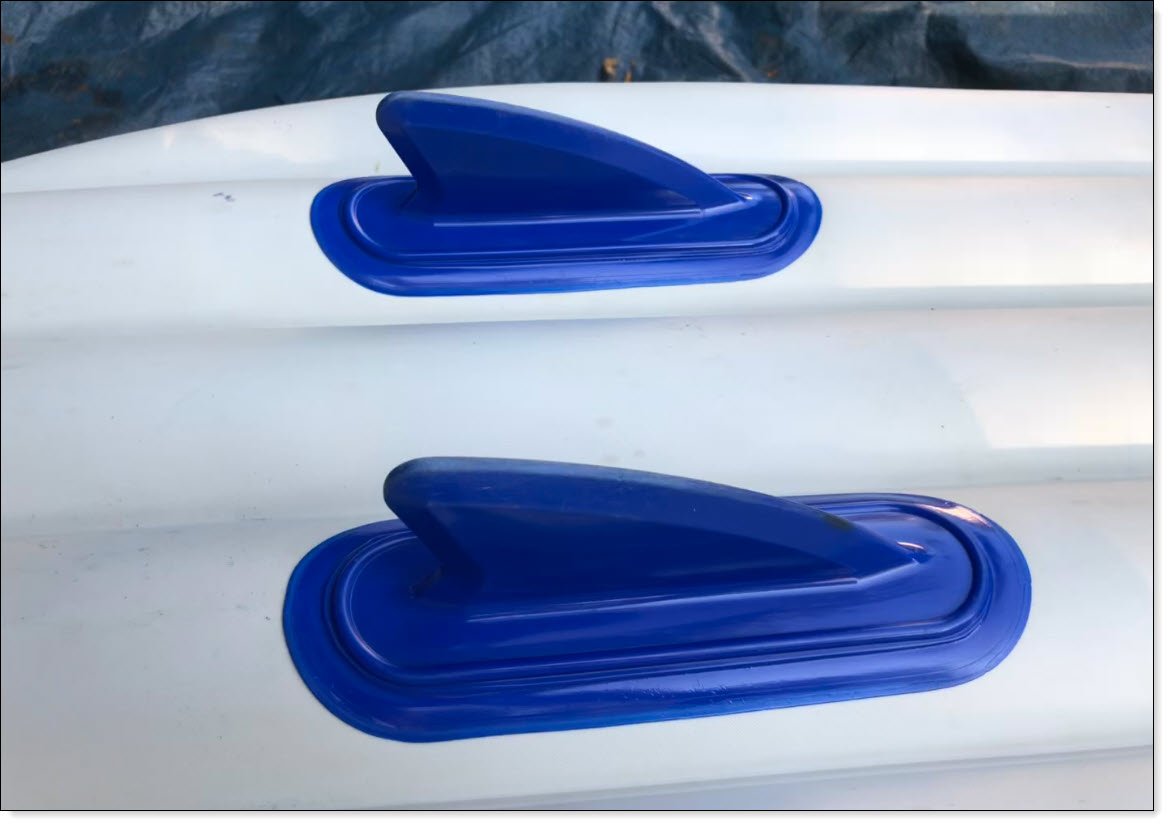




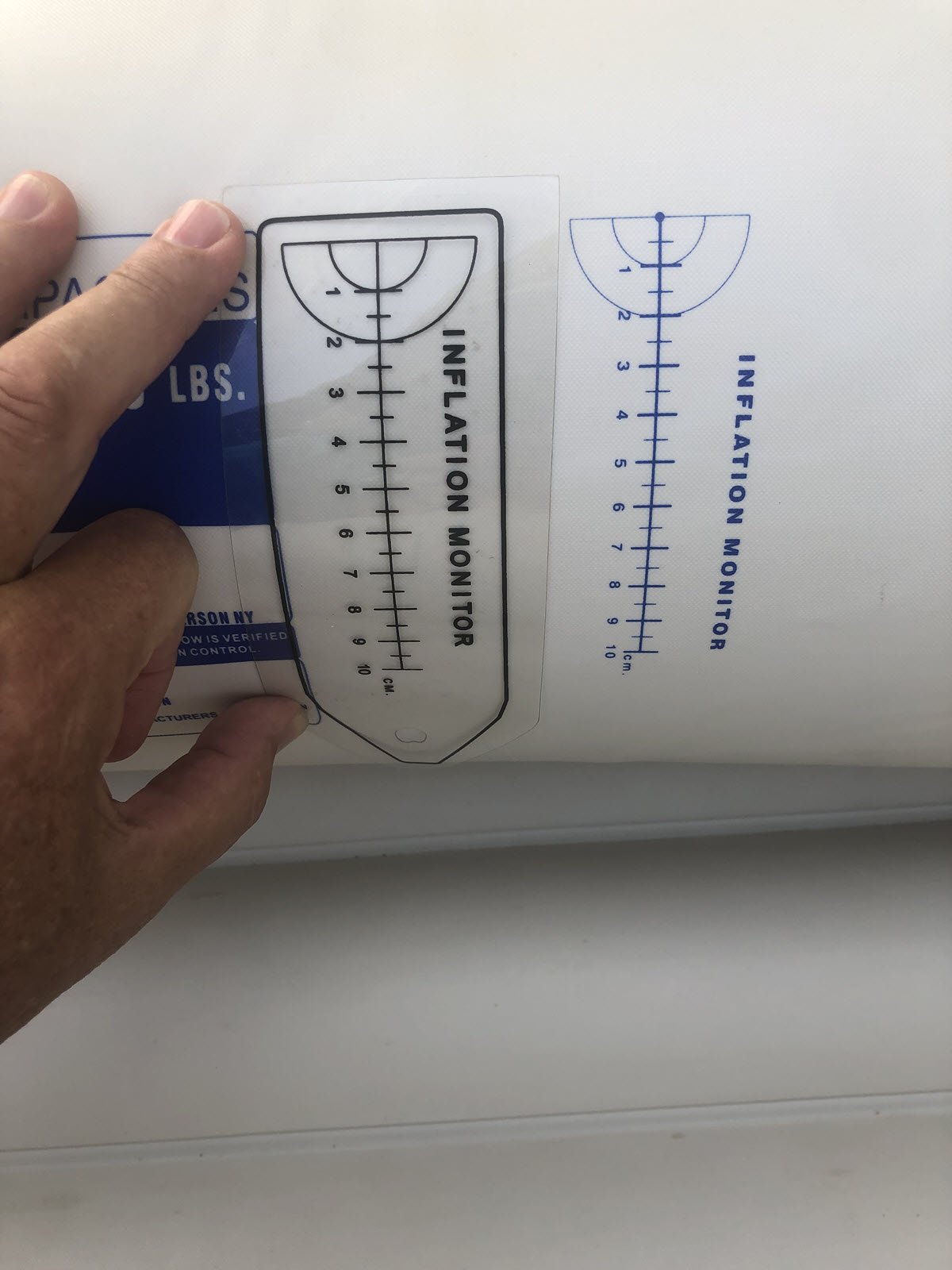

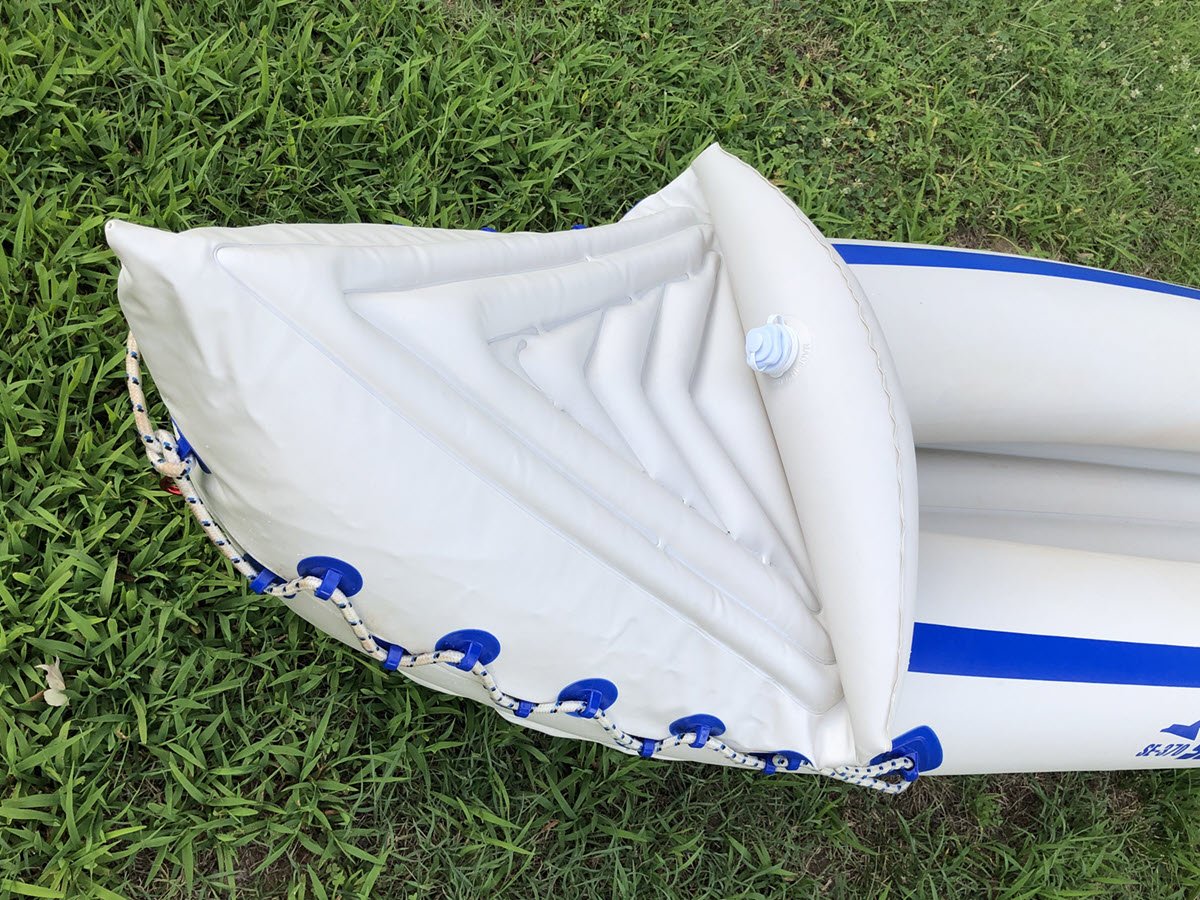
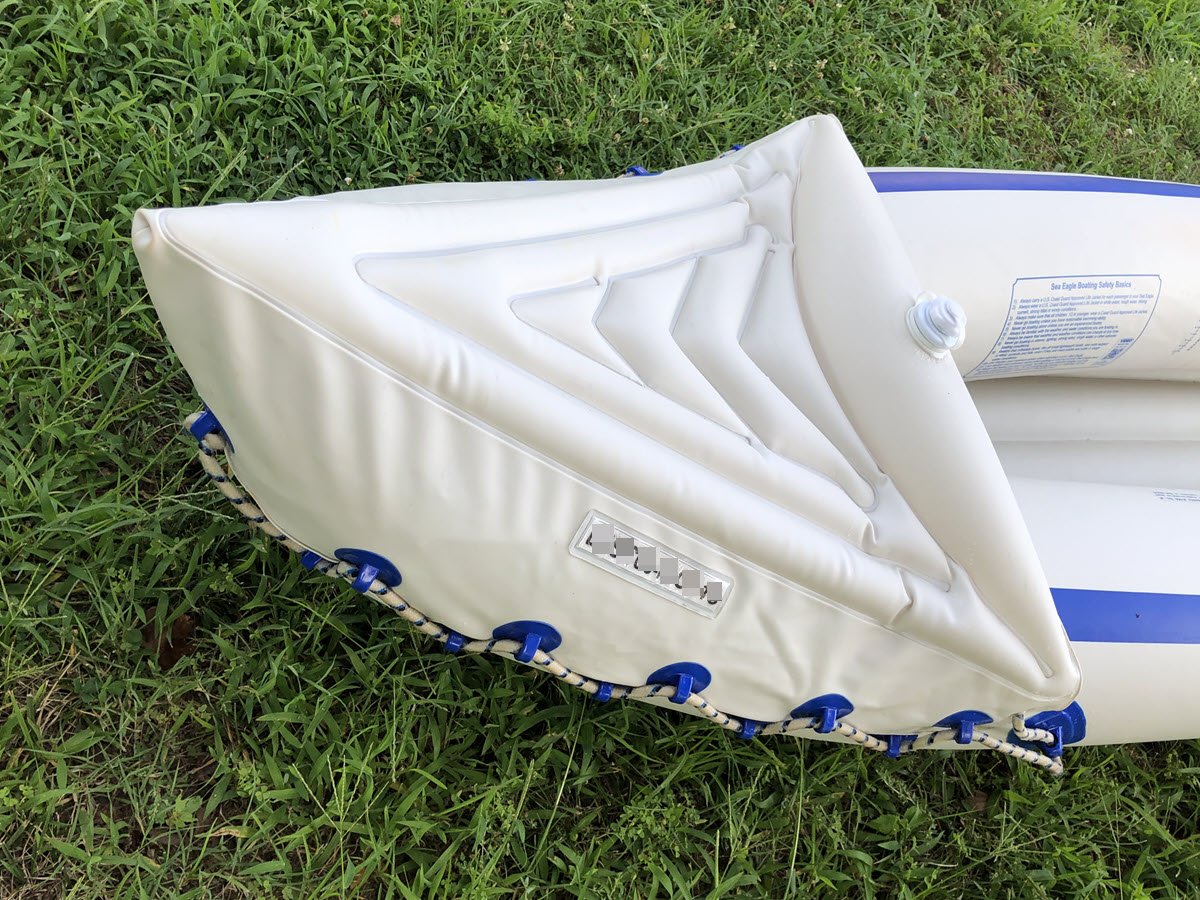

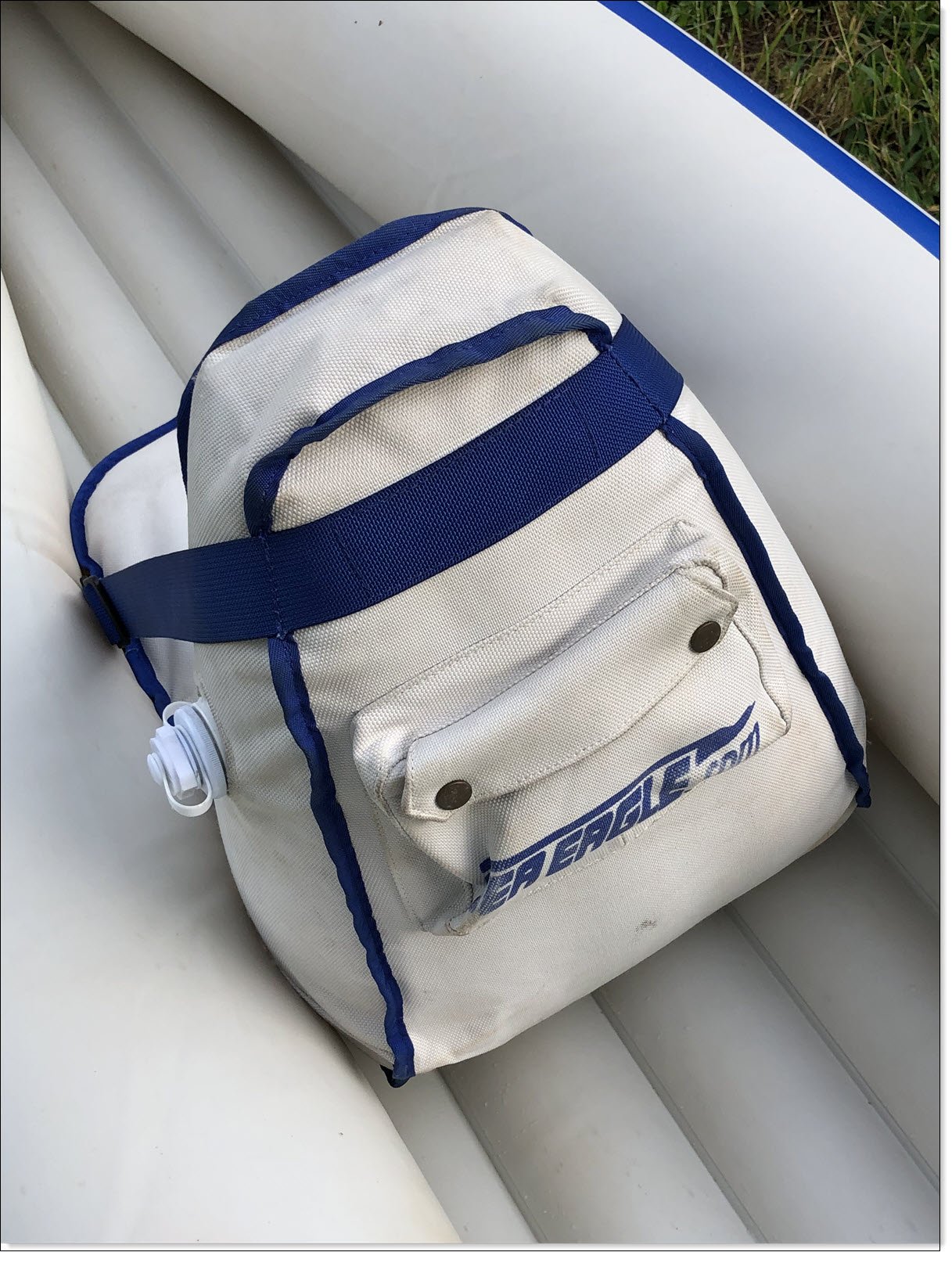
[…] Review: Sea Eagle 370 Inflatable Kayak […]